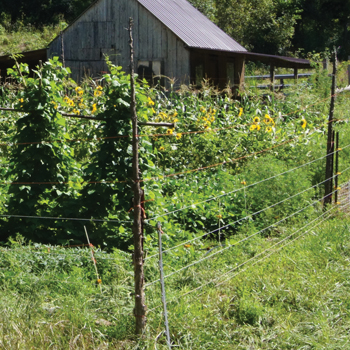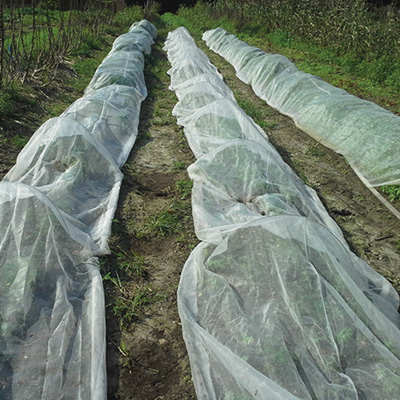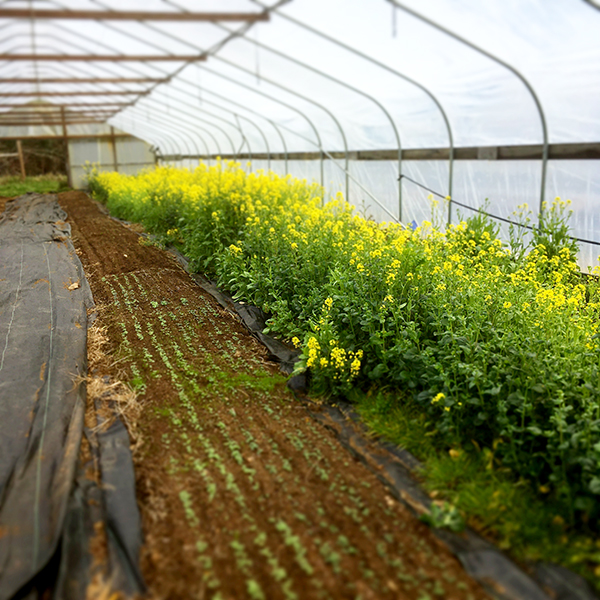Old-time farmers built fences to be horse high, hog tight, and bull strong. The ecology of farming has changed; we find that our vegetable fences need to be deer high, rabbit tight, and raccoon hot. Though we appreciate biodiversity, keeping wildlife from undercutting our harvests is essential. We have had ample opportunity to experiment with fencing styles, due to our use of several non-contiguous growing areas whose boundaries are dictated by geography and property lines. Here, we share some fencing strategies developed over eight years of experimentation on our diversified, wildlife-rich farm.
The ideal fence would exclude all undesirable critters while allowing easy access to beneficial fauna (including farmers), be long-lasting and easy to maintain through all seasons, and be affordable to acquire and construct. Reality isn’t so simple. Our initial instinct was to build a single, long-lasting fence intended to keep everything out, but our system has evolved to a long-lived perimeter fence aimed primarily at deer exclusion, combined with temporary fences around specific crops at specific times for raccoon or rabbit exclusion. In our experience, raccoons ignore physical barriers but are excluded by the shock delivered from a hot electric line, rabbits are the other way around, and deer can be controlled by either or both. We have just begun to experience groundhog trouble; early results suggest electricity is effective against these as well.
The fences we’ve used can be categorized according to type of barrier (physical vs. electric) and lifespan (temporary vs. multi-year), along with some hybrid approaches. We’ll first discuss some pros and cons of each general category, and then consider some details of our actual farm fences.
Physical-barrier fences
Physical fences block entry, often with a plastic or metal mesh such as chicken wire, woven wire, or welded wire. Fence posts are needed to keep the barrier upright; these may be metal, fiberglass, wood, or some combination. The security and lifespan of the fence generally increases with the cost of materials and care taken in building it. Well-built physical-barrier fences persist through all weather conditions and power outages, an important consideration for a farm like ours that hosts wild deer plus domestic goats and hogs. However, it takes a fair amount of material to form those barriers and fence posts, and the most durable materials can result in a very expensive fence.
Below: The authors built this heavy-duty fence of cedar posts, T-posts, and welded wire around their main vegetable field. It has done a great job of keeping out deer.

Trouble arises when animals squeeze through, dig below, or climb/jump over the barrier. To keep animals from squeezing through, a small enough mesh size is important; rabbits can fit through a 2”x4” gap. Fences can be buried to deter digging, but this may drastically reduce life span by putting the fence material in direct contact with soil; buried chicken wire lasts only a few years for us. A visual barrier is often enough to prevent deer from jumping. Many sources say that deer fences need to be a full eight feet tall, but adding an outward-angled extension significantly adds to the necessary jump arc, allowing for a lower fence. Making a physical-barrier fence impenetrable to climbers is difficult, though some strategies exist (such as mesh that continues out at a 45º angle or a fence that is too floppy to climb).
Electric fences
Below: The authors’ electric fence is left up all year.

An electric shock is an effective deterrent for pests that are difficult to exclude physically, such as raccoons. Electric fences generally require less material than physical barriers; a few strands of thin wire can be as effective against deer as a wall of mesh. Poly wire, poly tape, or high-tensile wire can be strung between fence posts outfitted with insulators, and it’s generally possible to space posts more widely than for physical-barrier fences. Portable nets, discussed later, are another option.
Electric fences do require specialized infrastructure, including an energizer, a grounding rod, and a fence tester. Insulated fence clips, insulated wire or other feeder line, and spare portable insulated posts are often useful. Energizers come in two forms, portable solar units or plug-in ones that utilize AC power. After spending too much money on replacement batteries for solar energizers that failed us at critical times, we now use only AC energizers plugged in at our barn or house. Some of our fences connect directly to these energizers; others tie into our grid of livestock fences with insulated wire or poly wire.
Effectiveness can be reduced by various weather conditions, including very dry ground, wet conditions in combination with weed load, and snow or ice on the electric lines. Proper installation, grounding, and maintenance can help counteract these weaknesses. Also, routine monitoring of fence strength with a fence tester is essential.
Electric fences do come with safety and liability concerns. Getting shocked is generally just a painful nuisance for an adult, but in rare circumstances it can be hazardous for children or individuals with certain health conditions. Proper signage and verbal warnings to visitors are advisable.
Multi-year fences
Fences that are intended to last require cost and time up front but can be effective for years or decades if quality materials are installed properly. Such fences make sense for orchards or fields that host crops throughout the year and need protection from year-round pests such as deer. For us, building such fences has been a productive use of off-season time when vegetable work is lowest.
Below: On the left, a fence of chicken wire and electrified poly wire. On the right, the orchard fence of welded wire, which is also is used to pasture chickens.

Maintaining the physical integrity of a long-term fence may mean budgeting time to tension wire, brace posts, monitor power, and keep vegetation in check. It’s all too easy to justify brush and vines as habitat for birds and beneficial insects until it starts to pull down the fence. Maintenance options include mechanical (mowers, string trimmers, or scythes), fire, and grazing. Some farmers may choose to use herbicide. Design your fence with a maintenance plan in mind. Consider, for example, if mesh will stand up to an occasional scrape with a scythe, if fire will cause plastic on the fence to melt, or if grazing in proximity to produce will be of concern to food-safety regulators.
Also consider the long-term implications of your fencing choices. What will a fence be like to renovate or replace? Ripping out rotten buried chicken wire, overgrown with poison ivy and multiflora rose, is unpleasant. Living trees shouldn’t be used as fence posts; they’ll grow over metal, creating hazards for chainsaws or sawmills. Will your fence become a chemical hazard, as with treated wood, or a physical hazard, as did our predecessor’s barbed wire which still laces our woods?
Temporary fences
We define temporary fences as those set up around a specific crop during a vulnerable part of its growth, usually for a few weeks to a couple months. Such fences are especially good at excluding rabbits and raccoons, which are difficult to fence out of an entire field. Because these fences aren’t tall, they don’t need gates; we simply step over them. Temporary fences take valuable time to put up and take down during the busy growing season; this approach is best suited for high-value or high-demand crops whose return or popularity will justify the extra precaution.

Keeping the weed load in check around temporary fences, particularly electric ones, is important. We prefer to set these fences in such a way that we won’t need to maintain vegetation in the right of way during use. Thus, we prepare a swath of bare or mulched soil that is at least 1 foot wide along the intended route. Mowed grass or clover re-grows quickly under most conditions and clogs the fence.
Our crop rotation and fencing approaches co-evolved, and we plant crops to get multiple uses out of a temporary fence in a year. For example, a single fence might protect strawberries, then move to sweet corn, and finally to late melons. Bed layout affects the efficiency of using temporary fencing to protect a specific crop. We put most crops that require temporary fencing into blocks that are closest to being square, because the ratio of perimeter to internal area requires less fence length to protect the same area than for very elongated beds.
Fencing examples
We will now transition to discussing specific examples of fencing implemented on our farm, representing various combinations of approaches, as illustrated in the photos. The fences are composed of materials purchased used or new, as well as cedar posts harvested on farm. These fences represent examples from an arc of learning, and we point out some good and bad results.
Physical, multi-year
Our main vegetable field is surrounded by welded wire mesh with a 2”x4” grid, 5’ high, strung between alternating cedar posts and T-posts spaced 8’–10’ apart. The cedar posts are topped with smaller wooden extensions, screwed onto the posts at an outward angle. We strung baling twine along these extensions, raising the total fence height to around 7’ and broadening the total arc a deer must jump to clear it. Although the lines sometimes sag to six feet, the fence has been exceptionally effective. However, the braces fail periodically, particularly when lines are weighted with heavy snow or vegetative growth; our new preferred method for fence height extensions is discussed later. With occasional maintenance of the high lines and a firm rule to always close the gates, the fence in its current form has not been penetrated by deer, in spite of close proximity to active deer trails.
Built in 2009, this fence is showing its age. The wire mesh was purchased used, already a bit unruly, and is definitely starting to sag and bend. Tensioning welded wire wasn’t a skill we had when we installed this fence (but the internet later taught us how). Some posts are slowly going out of alignment, and vines climb it more aggressively each year. A thorough rebuild is due within a couple of years, approximately on schedule with new concepts of how we want to manage this area.
Physical, temporary
Below: Rabbits are excluded from young crops by a simple temporary barrier of 2-foot chicken wire.
Rabbits are a major predator on our young peas, beans, sweet potatoes, and lettuce. Based on qualitative judgment about rabbit populations, we decide when vulnerable crops need protection provided by temporary barriers, particularly 2 foot chicken wire supported by portable fence posts or rebar. We ensure reasonable contact with the ground on the perimeter, and we’ve found that our rabbits have not been aggressive about penetrating such a barrier, perhaps because they have an abundance of tasty clover in the aisles. Another approach, using shade cloth over hoops, has excluded rabbits from young fall brassica transplants, with a bonus of some protection against extreme heat as well as considerable exclusion of adult cabbage moths/butterflies. Both chicken wire and shade cloth show signs of wear and tear, and we aren’t optimistic that either will last beyond five years of heavy use.
Electric, multi-year
One of our growing areas, used for summer annual production and winter cover crops, is protected by electrified poly wire strung through insulators on metal T-posts spaced 20 or more feet apart. Lightweight poly wire puts far less stress on corner posts than heavier high-tensile wire; we haven’t had to brace the corner T-posts in any way for this small 60’x100’ field. Insulators are spaced to allow for up to five poly wire lines. To discourage deer jumps, high lines of baling twine are strung on a second set of posts, described in more detail below.
This fence was partly inspired by the two-strand, steeply angled deer fence in Richard Wiswall’s The Organic Farmer’s Business Handbook. The five strands of our fence may be excessive for just deer exclusion, but the lowest insulators are spaced in a way to be useful for discouraging raccoons when crops are vulnerable. Use of the lowest strands requires us to do extra maintenance on vegetation under the lines. We have a power jump between the lower and upper strands so that we can remove power from the lower strands if they get overgrown in vegetation. We installed a chain-link gate at one corner, lashed between two T-posts, but an electric net gate (described below) is preferable during seasons of raccoon vulnerability, as it extends electricity all the way around the field.
The height extensions for this fence represent our current preferred method. [Refer to the hybrid, multi-year fence photo on page 14 for the best illustration of this technique.] We use 10’ wooden posts (small cedar trunks), each one sheer-lashed to a regular T-post, installed at an angle of about 10º from vertical. This allows us to use our abundant cedar posts rather than purchasing expensive tall T-posts. The narrow post angle does not greatly hinder tractor mowing near the fence, but provides an element of three-dimensionality to deter deer. High lines of baling twine are tied to the posts at a height of 6’ and 7’ using a knot that allows for easy re-tensioning as needed. The T-posts make installation easy, requiring only a manual post driver rather than an auger. The cedar posts are rot resistant, especially without significant soil contact. There are no screws or joints that can fail.
We typically leave the poly wire up year round, but we can remove some or all of the strands as needed to provide better access for maintenance, such as scything vegetation or full tractor access into the field. This fence has been operational for three years and is our choice for areas that don’t need reliable winter protection.
Electric, temporary
Two or three strands of poly wire or tape, the lowest about 4” from the ground and the highest about 14”, can be effective against raccoons. We used T-posts fitted with plastic insulators as corner posts and portable insulated posts in intermediate locations as needed to maintain proper strand spacing. Though this method was effective, it was more time consuming to set up than electric nets, and we abandoned this approach in favor of nets. On the other hand, keeping weed pressure down can be easier than with a net, as it is possible to hoe directly below the lowest line without moving the fence, and low weed load helps to maintain high voltage.
Hybrid, temporary Electrifiable nets, consisting of flexible plastic/poly wire mesh with built-in posts, are most commonly used for rotational grazing of livestock/poultry, but pest-specific versions are also available. They are quick and easy to set up and move, providing some protection with a physical barrier, although the electric current is their main deterrent. We purchased our nets from Premier1 Supplies, whose website is a good source of electric fence information and advice. The 18” high raccoon nets have proven extremely effective, if set up prior to the stage at which the crop is ripe enough to be tempting. Our rabbits, however, have learned to hop right through nets. Hog nets, with a hot wire for their lowest line, are also effective against raccoons in a vegetable context. Fence strength can be sapped by weed load or by sections of fence that sag to the ground; the latter concern would have been alleviated if we had purchased the raccoon net model with closer post spacing. When not in use, we hang rolled-up fences from barn rafters for safe keeping. Our raccoon nets are about four years old and as good as new. Taller versions of electric nets are also sold in short lengths intended for use as gates, and these can be useful in more permanent electric fences.
Hybrid, multi-year
A hybrid physical/electric fence keeps out deer through a physical barrier as well as an extra punch of electric at nose height. If executed properly, it can also keep out climbers such as raccoons, because electric lines above the mesh barrier prevent climbers from going up and over. Electric lines could also be installed horizontally outward from a well-tensioned mesh by using extended fence insulators. Raccoons can scale a physical gate, but electric net gates can fill that gap.
Two of our growing areas use hybrid fences. Our smallest growing area uses 3’ chicken-wire with electrified poly wire and baling twine strung above. Our orchard, a maximum-security area, uses welded wire mesh 3’-4’ tall stretched between solid 8’ cedar posts, framed in with farm-cut cedar planks, two lines of high-tensile metal wire stretched tight, and baling twine above that as a final jump barrier.
The chicken-wire fence has been our weakest, as chicken wire just doesn’t stand up to the elements. The bottom (buried slightly) rusts away quickly, while the top sags easily, creating gaps between it and the electric lines. The original intention of excluding rabbits worked for only a couple of years. Poly-wire electric strands at deer-nose height (3’ and 4’), in combination with our usual higher anti-jump lines of twine, have effectively excluded deer. We actually kept deer out for years with just twine, even at nose height, but one trampled its way over the chicken wire after a heavy snow, and we decided to upgrade to electric. This whole fence is due for a rebuild, but chicken wire won’t be part of the replacement.
The orchard fence has the added duty of providing security for the chickens pastured within at times. The physical barrier on bottom excludes ground predators like coyotes and foxes while restricting the birds; the hybrid approach effectively bars deer. We placed electric lines just above the wire mesh in hopes of deterring raccoon climbing, but we do not yet have an electric barrier around the entire perimeter, so judgment of its effectiveness is premature. The cedar planks framing the wire mesh help to protect the fence from our scythe while stiffening the mesh, though adapting this design to variable terrain was a challenge not entirely solved.
Conclusion
The details of how to build fences are beyond the scope of this article. The internet has an abundance of resources that describe how to build a good fence: how to set posts, tension welded wire, install grounding rods, and much more. We may forever be in quest of the perfect fence, the one that provides peace of mind, protects crops from all wildlife, and is aesthetically pleasing, without becoming an overgrown tangle, a money pit, and a maintenance hassle. In the meantime, we hope that some of our approaches will be informative to others.
Joanna and Eric Reuter are the owners of Chert Hollow Farm in Missouri. They’ve sold produce through market, wholesale, and CSA outlets. Email them at [email protected].





 Here's a system to track all those details
Here's a system to track all those details






 If you’ve been a subscriber to Growing For Market (or even if you haven’t), you’re probably familiar with the many advantages of no-till agriculture. No-till methods can reduce a farm’s carbon footprint, promote complex soil biology, and preserve and build organic matter.
If you’ve been a subscriber to Growing For Market (or even if you haven’t), you’re probably familiar with the many advantages of no-till agriculture. No-till methods can reduce a farm’s carbon footprint, promote complex soil biology, and preserve and build organic matter.
 Until two years ago I was germinating all seedlings in greenhouses using almost exclusively bottom heat from electric heat mats. At my current farm we only had space for about 8-10 trays on our two mats and we definitely noticed differences in the germination (and presumably the heat the mats were providing) on the edges of our trays.
Until two years ago I was germinating all seedlings in greenhouses using almost exclusively bottom heat from electric heat mats. At my current farm we only had space for about 8-10 trays on our two mats and we definitely noticed differences in the germination (and presumably the heat the mats were providing) on the edges of our trays.

 Over the last three years, I’ve been involved with a new experimental farm in my province of Quebec. At my farm, La Ferme de Quatre Temps, I was asked to design and create a training farm where some of the strategies described in my book
Over the last three years, I’ve been involved with a new experimental farm in my province of Quebec. At my farm, La Ferme de Quatre Temps, I was asked to design and create a training farm where some of the strategies described in my book 